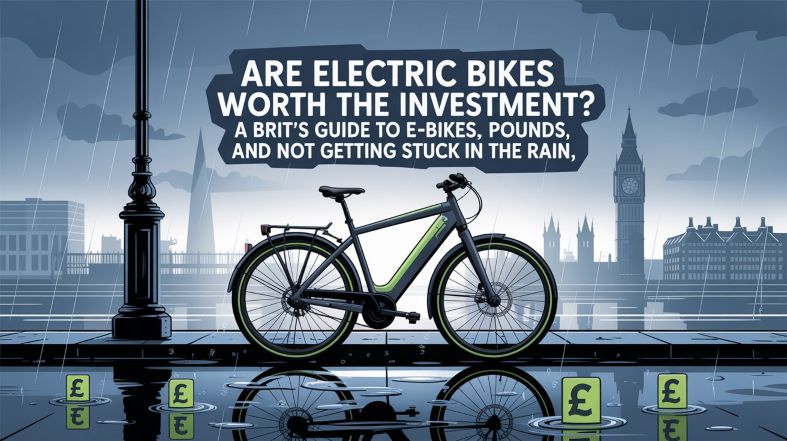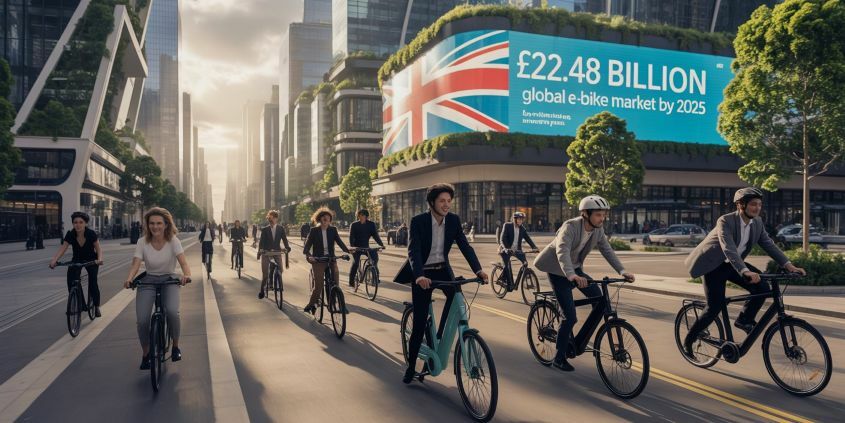I’ve been using electric bikes for 5 or 6 years now, and during that time, I’ve noticed that the batteries inevitably degrade over time. This got me thinking: how are electric car owners going to deal with battery degradation? Surprisingly, the answer is actually quite good. Most electric vehicles have advanced temperature control systems that help preserve their battery life by maintaining an optimal operating temperature.
Unfortunately, electric bikes don’t have the same luxury. One of the main reasons batteries lose capacity is due to exposure to extremely high or low temperatures, which accelerates wear and reduces their lifespan. This lack of temperature management makes it even more critical for e-bike owners to understand how to care for their batteries to maximize their performance and longevity.
Have you ever touched your ebike battery after a long ride or maybe up a steep incline, and thought wow that is actually quite hot, I realise there is not much you can do about this, but actually being more aware of this issue will help you preserve your e-bike battery life?
Tips to Maximize Your Electric Bike Battery Life
- Optimal Charging Practices:
- Follow the 20%-80% rule: Avoid charging to 100% or letting it drop below 20% regularly (if possible)
- Charge at room temperature to prevent overheating.
- Use a smart charger to avoid overcharging.
- Temperature Management:
- Store the battery in a cool, dry place.
- Avoid exposing the battery to direct sunlight during rides.
- Let the battery cool down before charging after long rides.
- Regular Use:
- Use the battery frequently to keep it active and healthy.
- Avoid long periods of inactivity, but if storing, leave it at around 40%-60% charge.
- Storage Tips:
- Remove the battery from the bike if stored in extremely hot or cold environments.
- Check the battery condition periodically during long storage.
- Charging Habits:
- Avoid fast chargers, as they can generate heat and degrade cells.
- Disconnect the charger once fully charged to prevent voltage stress.
- For some e-bikes, occasionally allowing the battery to discharge fully (once every 2-3 months) helps recalibrate the battery’s management system.
- Maintenance:
- Keep battery terminals clean and dry for optimal performance.
- Regularly inspect the battery casing for any signs of damage.
- Riding Efficiency:
- Use pedal-assist modes instead of full throttle to reduce battery strain.
- Avoid unnecessary weight on the bike, as it increases power demand.
- Upgrade Smartly:
- Consider chargers with programmable options to limit charging to 80%.
- Use batteries compatible with your e-bike to ensure efficient energy transfer.
If you wish to learn more about bikes that use batteries you can here.
1. The Secrets Behind Electric Car Battery Longevity
EV batteries are designed to last for hundreds of thousands of miles, often outlasting the cars themselves. Here’s how manufacturers ensure their longevity:
Temperature Moderation
- Why It Matters: Lithium-ion batteries degrade faster when exposed to extreme heat or cold. Temperature fluctuations can cause internal components to break down.
- How EVs Handle It:
- EVs use advanced thermal management systems (TMS), which include liquid cooling or heating to keep the battery at an optimal temperature (usually 20°C–30°C or 68°F–86°F).
- This system prevents overheating during charging or strenuous use and keeps the battery warm in cold weather.
- The Benefit: By maintaining a stable temperature, EV batteries avoid the rapid degradation seen in unregulated systems.
State of Charge (SOC) Management
The Benefit: Maintaining a partial charge range prolongs the battery’s overall lifespan.
Why It Matters: Lithium-ion batteries experience stress at high (100%) or low (0%) charge levels, leading to faster capacity loss.
How EVs Manage It:
Many EVs limit the usable capacity of the battery to keep it between 20% and 80% SOC, even if the dashboard shows “100%.”
You are probably thinking well how does this relate to ebikes, well it gives you an explanation as to why electric car batteries last so long compared to electric scooters and electric bike batteries and you can use this information to help you maximise your ebike battery.
Did you know? The last 10% of charging takes the longest because the system slows down to balance cells and protect the battery. Charging between 20% and 80% is faster and better for long-term health.
b
2. Why Phone Batteries Die So Quickly
In contrast, mobile phone batteries often degrade rapidly. Here’s why:
Heat Build-Up
- Why It Happens:
- Phones lack active cooling systems, relying on passive heat dissipation through their casings.
- High-performance tasks (e.g., gaming or video recording) and fast charging generate significant heat, which accelerates wear on the battery.
- The Result: Without temperature regulation, chemical reactions inside the battery speed up, causing capacity loss and, in severe cases, swelling or damage.
Frequent Full Charging
- Why It Happens:
- Many people charge their phones to 100% and leave them plugged in overnight, exposing the battery to high voltage for extended periods.
- The Result: This stresses the battery, reducing its lifespan.
High Usage Cycles
The Result: More frequent cycles accelerate the natural wear and tear on the battery.
Why It Happens:
Mobile phones often go through a full charge-discharge cycle daily, compared to less frequent use for EVs or e-bikes and mobile phones get very hot! this heat is bad for the battery.
3. How This Applies to E-Bike Batteries
E-bike batteries share characteristics with both EVs and phones but operate under unique conditions. Let’s explore how heat and charging habits affect their longevity and what riders can do to maximize battery life.
Temperature Challenges
- Heat During Use:
- Long rides, especially in hot weather, can cause the battery to heat up.
- Unlike EVs, most e-bikes lack active thermal management systems, relying on passive cooling.
- Heat During Charging:
- Charging the battery generates heat, particularly if it’s already warm from use or stored in a hot environment.
Charging Practices
- Why It’s Hard to Follow the 20%-80% Rule:
- Unlike EVs, e-bikes often don’t have built-in systems to restrict charging to 80%.
- Riders often charge to full capacity to maximize range, especially for long rides.
- Some bikes and chargers do have this facility though.
- Most of the time ebikers need a full charge, part charging is not as convenient.
- The Impact:
- Frequent full charges and deep discharges put more stress on the battery, reducing its lifespan.
You can find out more about how to calculate the range of your bike here.
Now, let’s move on to our next topic – The maintenance of Electric Bike Batteries.
4. How to Protect Your Battery From Heat and Temperature Damage
- Avoid Extreme Temperatures:
- Keep the battery out of direct sunlight.
- Store the battery in a climate-controlled space (around 15–25°C or 59–77°F).
- Cool Down Before Charging:
- After a long ride, let the battery cool to room temperature before charging.
- Moderate Charging Conditions:
- Charge at room temperature; avoid charging in a very hot or very cold environment.
- Ride Smart in Hot Weather:
- Take breaks during long rides to prevent the battery from overheating.
- Use lower pedal-assist levels to reduce the power demand and heat generation.
- Insulate in Cold Weather:
- If riding in cold temperatures, use a thermal cover for the battery to retain some warmth and maintain efficiency.
- Store Wisely:
- For extended storage, keep the battery at 40–60% charge in a stable, moderate environment.
- Avoid leaving the battery in freezing or sweltering locations (e.g., garages or cars).
- Regular Maintenance:
- Check for any signs of overheating, swelling, or damage, and address them promptly.
4. Practical Tips for E-Bike Battery Care
Temperature Moderation
- Store the battery in a cool, dry place (10°C–25°C or 50°F–77°F).
- Avoid charging the battery immediately after a long ride. Let it cool for 30–60 minutes.
- On hot days, take breaks during rides to prevent overheating.
Charging Habits
- Charge to full only when you need maximum range.
- For daily use, unplug the charger when the battery reaches around 80% (if possible).
- Avoid letting the battery drain completely before recharging.
Riding Practices
- Use lower assistance levels (e.g., Eco mode) on flat terrain or short trips to reduce strain on the battery.
- On hilly rides, monitor the battery temperature and adjust your pace if it starts to warm up.
Storage Tips
Avoid leaving the battery in direct sunlight or freezing temperatures.
If you’re storing the bike for an extended period, keep the battery at around 50% charge.
5. How E-Bike Batteries Compare to EVs and Phones
| Feature | EV Batteries | Phone Batteries | E-Bike Batteries |
|---|---|---|---|
| Temperature Control | Advanced thermal management | No active cooling | Passive cooling only |
| SOC Management | Restricted to 20%-80% | Full charge often used | Manual control by the user |
| Charging Speed | Optimized for longevity | Fast charging degrades battery | Standard charging with heat risks |
| Usage Cycles | Less frequent | Daily cycles | Full charge is often used |
Answers to Frequently Asked Questions with Detailed Explanations
How should an ebike Battery be charged and stored?
Electric bike batteries should be charged and stored in a cool, dry place as recommended by the manufacturer. You can store them in a garage or shed during the warmer months, but you will need to bring them indoors in the winter months. It’s best to charge your battery only when it reaches around 25% capacity and charge it up to around 85%. This will help keep your battery healthy and ensure it lasts longer. When storing your battery, make sure that it is in an area that doesn’t exceed the temperature of 40 degrees Celsius (104 degrees Fahrenheit). Additionally, never overcharge an electric bike battery; this can cause irreversible damage to the lithium-ion cells within the battery. Finally, always check the voltage and amps of the charger before use, as improper charging can cause overheating of the battery and even reduce its life cycle.
How long do ebike batteries last?
The answer to how long electric bike batteries last depends on a variety of factors, such as the type of battery, how it’s maintained, and how it’s used. Generally speaking, electric bike batteries can last anywhere from two to five years with proper care and use. Lithium-ion batteries are typically considered more reliable than lead-acid batteries, though both types require regular maintenance in order to keep them in good condition. It is important to carefully read the instructions for charging and storing the battery in order to extend its lifespan. Additionally, riding habits can significantly impact a battery’s lifetime; for example, hills can reduce range and put an additional strain on the power system. With these points in mind, it should be possible for an electric bike battery to serve you well for several years with proper care.
What should I do if my electric bicycle battery stops holding a charge?
If your electric bike battery stops holding a charge, the first step is to check if it’s still under warranty and contact the manufacturer for a replacement. However, if your battery is out of warranty, or you prefer to fix it yourself, there are a few things you can try. Start by fully draining and recharging the battery a few times to recalibrate its charging system. If that doesn’t work, consider replacing individual battery cells or consulting a professional repair service. Remember, proper maintenance and regular charging cycles can significantly extend the lifespan of your electric bike battery. According to industry data, on average, electric bike batteries can last between 3 and 5 years with proper care and usage.




